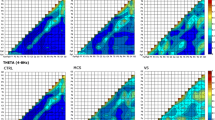Abstract
The relationship between the level of consciousness and the level of brain activation was studied. A model for a gradual decrease in the level of consciousness was provided by the transition from waking to drowsiness. Measures of the level of consciousness, assessed by the subjects themselves, consisted of changes in the content of consciousness, i.e., the intensity and quality of involuntarily arising mental processes. In each subject, the level of consciousness was found to correspond to a pert EEG profile. The results obtained from these studies showed that the lowest level of activation corresponded to the state in which the subject noted inhibition of “inner speech,” a “lapse of thoughts,” and in this state the interhemisphere associations involving the major mechanism of transmission of cognitive information, i.e., the high-frequency EEG rhythm, was weakened.
Similar content being viewed by others
REFERENCES
A. S. Aslanov, N. A. Gavrilova, E. B. Sologub, and T. L. Khrizman, “Spatial synchronization of electrical activity in the human brain in health and pathology,” in: Spatial Synchronization of the Human Brain [in Russian], Nauka, Moscow (1973), pp. 128–167.
G. N. Boldyreva, Electrical Activity of the Brain in Lesions of the Diencephalic and Limbic Structures [in Russian], Nauka, Moscow (2000).
A. M. Vein, Waking and Sleep [in Russian], Nauka, Moscow (1979).
G. Yu. Volynkina and N. D. Suvorov, The Neurophysiological Structure of Emotional States in Humans [in Russian], Nauka, Leningrad (1981).
N. N. Danilova, Psychophysiology [in Russian], Aspekt Press, Moscow (1998).
I. S. Dobronravova, “Reorganization of electrical activity in the human brain on suppression of thought activity (comatose states),” Zh. Vyssh. Nerv. Deyat., 40, No.6, 1105–1115 (1990).
A. R. Luriya, The Brain and Consciousness, Moscow State University Press (1979).
L. P. Pavlova and A. F. Romanenko, A Systems Approach to Psychological Studies of the Human Brain [in Russian], Nauka, Leningrad (1988).
M. N. Rusalova, Experimental Studies of the Emotional Reactions of Humans [in Russian], Nauka, Moscow (1979).
M. N. Rusalova, “The effects of emotions on activation of the left and right hemispheres of the brain,” Fiziol. Cheloveka, 14, No.5, 754–761 (1988).
M. N. Rusalova, “Levels of consciousness and levels of activation,” Zh. Vyssh. Nerv. Deyat., 40, No.6, 1097–1104 (1990).
M. N. Rusalova, “Voluntary regulation of levels of consciousness,” Zh. Vyssh. Nerv. Deyat., 50, No.2, 200–205 (2000).
V. S. Rusinov, O. M. Grindel’, N. N. Bragina, E. V. Sharova, D. Barkalaya, A. G. Korshunov, and G. A. Shchekut’ev, “The “locked-in” patient and the characteristics of the electrical activity of his brain,” Zh. Vyssh. Nerv. Deyat., 40, No.2, 218–224 (1990).
V. S. Rusinov, O. M. Grindel’, G. N. Boldyreva, E. M. Vakar, and V. E. Maiorchik, The Diagnosis and Prognosis of Functional States of the Human Brain [in Russian], Nauka, Moscow (1988).
P. V. Simonov, The Emotional Brain [in Russian], Nauka, Moscow (1981).
V. M. Smirnov, Stereotaxic Neurology [in Russian], Meditsina, Leningrad (1976).
D. L. Spivak, The Linguistics of Altered States of Consciousness, Nauka, Leningrad (1986).
E. N. Sokolov, “Neurophysiological mechanisms of consciousness,” Zh. Vyssh. Nerv. Deyat., 40, No.6, 1049–1052 (1990).
R. L. Solso, Cognitive Psychology, Trivol Press, Moscow (1996).
E. D. Khomskaya, The Brain and Activation [in Russian], Moscow State University Press, Moscow (1972).
A. N. Shepoval’nikov, Activity in the Sleeping Brain [in Russian], Nauka, Leningrad (1986).
R. Hernandez-Peon, Physiological Mechanisms and Attention. Frontiers in Physiological Psychology, Academic Press, New York (1966), pp. 121–147.
H. W. Magoun, The Waking Brain, Charles C. Thomas, Springfield (1963).
Author information
Authors and Affiliations
Additional information
__________
Translated from Rossiiskii Fiziologicheskii Zhurnal imeni I. M. Sechenova, Vol. 90, No. 7, pp. 840–848, July, 2004.
Rights and permissions
About this article
Cite this article
Rusalova, M.N. Characteristics of Interhemisphere Interactions at Different Levels of Consciousness. Neurosci Behav Physiol 35, 821–827 (2005). https://doi.org/10.1007/s11055-005-0131-0
Received:
Revised:
Issue Date:
DOI: https://doi.org/10.1007/s11055-005-0131-0




